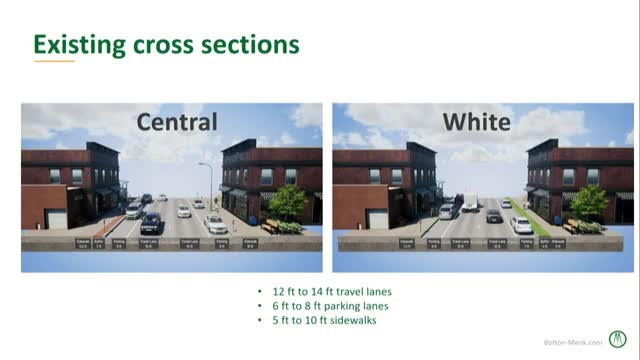City plans transformative redesign for Central and White streets
September 30, 2024 | Dubuque City, Dubuque County, Iowa
This article was created by AI summarizing key points discussed. AI makes mistakes, so for full details and context, please refer to the video of the full meeting. Please report any errors so we can fix them. Report an error »

In a recent government meeting, city planners presented several alternatives for the redesign of Central and White Streets, focusing on enhancing multimodal transportation and urban aesthetics. The discussions highlighted the current road specifications, which include travel lanes ranging from 12 to 14 feet, parking lanes between 6 and 8 feet, and sidewalks varying from 5 to 10 feet. The transition from Iowa Department of Transportation (DOT) oversight to city management means that state urban design specifications will now guide these changes.
One proposed alternative is a multimodal-focused design, which maintains the one-way configuration of both streets while removing parking on one side of each street. This change aims to create wider sidewalks conducive to landscaping and outdoor dining, alongside a two-way cycle track on White Street. The cycle track would be level with the sidewalk, providing a safer buffer from vehicular traffic.
Another significant proposal is the two-way alternative, which would convert both streets to two-way traffic with one lane in each direction. This design maximizes parking on both sides, with the addition of short left turn lanes at signalized intersections to alleviate traffic congestion caused by turning vehicles.
A third option, termed the \"slow flow\" alternative, retains the one-way configuration but reduces travel lanes to one in certain sections, allowing for increased amenities such as wider sidewalks and outdoor dining spaces. This approach is particularly aimed at enhancing connectivity between the millwork district and Main Street.
The meeting underscored the importance of balancing traffic flow with urban livability, as planners seek to create a more pedestrian-friendly environment while accommodating the needs of vehicles, particularly in areas with high truck and bus traffic. The proposed designs reflect a commitment to improving the streetscape and fostering a vibrant urban atmosphere.
One proposed alternative is a multimodal-focused design, which maintains the one-way configuration of both streets while removing parking on one side of each street. This change aims to create wider sidewalks conducive to landscaping and outdoor dining, alongside a two-way cycle track on White Street. The cycle track would be level with the sidewalk, providing a safer buffer from vehicular traffic.
Another significant proposal is the two-way alternative, which would convert both streets to two-way traffic with one lane in each direction. This design maximizes parking on both sides, with the addition of short left turn lanes at signalized intersections to alleviate traffic congestion caused by turning vehicles.
A third option, termed the \"slow flow\" alternative, retains the one-way configuration but reduces travel lanes to one in certain sections, allowing for increased amenities such as wider sidewalks and outdoor dining spaces. This approach is particularly aimed at enhancing connectivity between the millwork district and Main Street.
The meeting underscored the importance of balancing traffic flow with urban livability, as planners seek to create a more pedestrian-friendly environment while accommodating the needs of vehicles, particularly in areas with high truck and bus traffic. The proposed designs reflect a commitment to improving the streetscape and fostering a vibrant urban atmosphere.
View full meeting
This article is based on a recent meeting—watch the full video and explore the complete transcript for deeper insights into the discussion.
View full meeting
